(Written by William)
Whenever I have the chance to ask for some review copies from LEGO, I typically ask for sets that feature something unique or interesting from a building point of view. After all, examining advanced building techniques is where I get a great deal of enjoyment out of the hobby. This is partly why LEGO City sets are usually not on top of my review list. Even though I like the topic of LEGO City, there is not as much to keep my interest. Then, LEGO introduced the new road system in the 2021 LEGO City sets…

During more normal times, I’d be participating with my LEGO User Group at events where we put together a display. Anyone who has done a city display knows how tough it is to have roads that look good. In the past, I’ve considered the old road baseplates, but found them too limiting. Then I’ve tried a fan-created design where you build the roads with bricks and plates on their side. This does look great, but can get really expensive. Then I checked out the #854048 LEGO Xtra Road Tape. I found the tape to be okay for long stretches of straight roads (like an old highway), but for urban areas with more complex roads, it’s impractical.

Let’s say, just say that I had low expectations for the new system. And this is probably why it took me completely by surprise. What’s more is that I even had fun with the three new LEGO City sets with road plates that I built, despite them being simple in nature. They captured a very nostalgic feeling for me because of how straightforward everything came together (like in the earlier days of LEGO!). It also helped that every set had a strong narrative built into the model. The minifigs had a purpose for being what they were and doing what they did. Additionally, the 2021 LEGO City sets have a very forward-thinking theme with solar panels, electric vehicles, bike riding, and recycling. And then, there is the new road system.
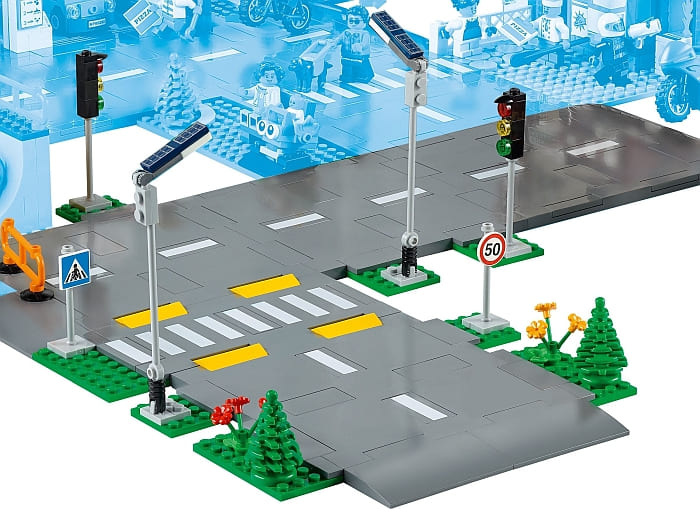
Not only is the road system well thought out, but the sets demonstrate various ways to modify them for different purposes. The road elements also managed to make city planning a breeze with regular points of connectivity. And best of all, the cars actually fit on the road and can stay in their own lane. And if all that wasn’t great enough, these are some of the early 2021 sets that are still available to buy. (I know this is a weird selling point, but under the current circumstances and with so many sets out of stock or backordered, I think it’s nice to provide a review that people can actually have a chance of acting upon.) Speaking of which, let’s look at the three sets I picked out featuring the new road system.
THE #60291 LEGO CITY FAMILY HOUSE
At $60 USD retail, the #60291 LEGO City Family House is the most affordable LEGO City set in the batch. It features a three-story home complete with carport, charging station for an electric car, yard, and a street section that has been taken over by the family to play some street hockey.
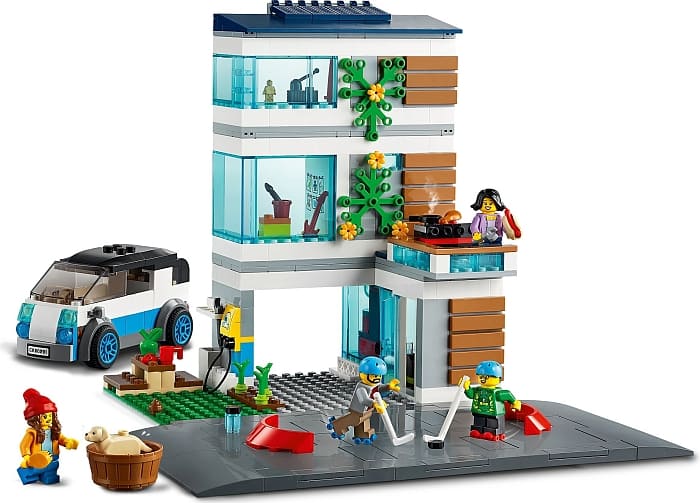
The building itself has relatively small interior spaces, but that didn’t stop LEGO from cramming in a couch, tv, small kitchen area with blender, a bathroom, an art and music room, and a child’s bedroom. Even the outside is packed with a second-floor patio, picnic bench, dog bath, garden, tool area, and solar panels. Honestly, even though this set is not a complex build, it is chock-full of play potential.
My main goal of getting this set was to see how it uses the new road plate system. In essence, we get one and a half road modules. A full module is 16×16 studs in dimension and sits two plates tall in height. LEGO also makes a half module, which is 8×16 studs in width and length and also two plates high.
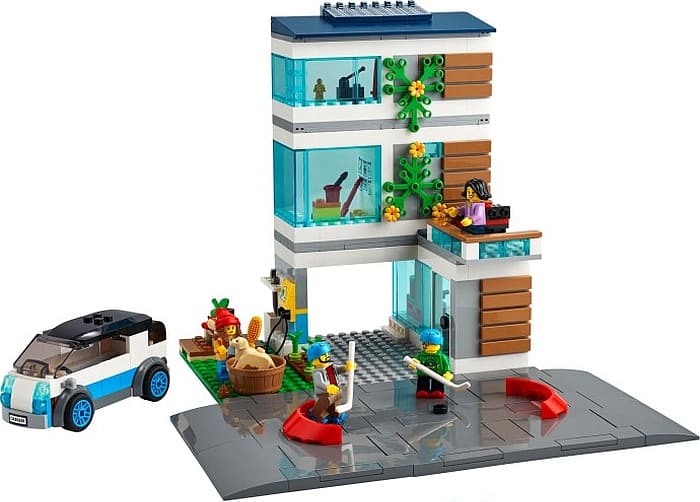
What this set demonstrates is how to use the new road plates for a residential road. In many suburban areas, there aren’t dashed lines in the middle of the street, which is how the road plates are used here. This set also shows us how easy it is to modify the road and how you can mount accessories onto it, like the hockey goals.
As this set only has two road elements, your options for modifying the street are limited, however the set still does a decent job at showing how easy it can be to take a single building and make it compatible with a much larger city that features the new road system.
THE #60292 LEGO CITY TOWN CENTER
At $100 USD retail, the #60292 LEGO City Town Center is the largest set currently featuring the new road system. This gives us a “T” intersection with a number of points of interest. There are a couple of recycling bins for glass and paper, a car wash which can accommodate even larger vehicles, a charging station for electric cars, a small park scene, and a couple of businesses.
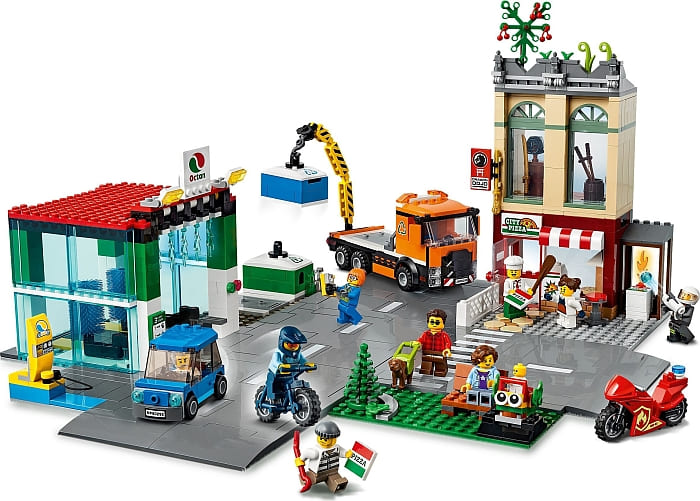
It’s interesting to see the representation in the model. We get a blind guy with his seeing-eye dog (I was rather impressed with the new dog harness). There is also representation of different cultures with a pizza eatery and a martial arts dojo (which looks to be perhaps a kendo place?). There’s a great gender balance in the set as well.
And, of course, we get quite a good selection of road modules. We also get to see how crosswalks are handled. The 8×16 half module is decorated with dashed lines along its entire length. Astonishingly, you simply add in some printed 2×4 tiles with the same line pattern, which then complete the crosswalk. These decorated tiles are also what are used for making the dashed lines on the main road, providing a very slick and polished look that really classes up the entire set.
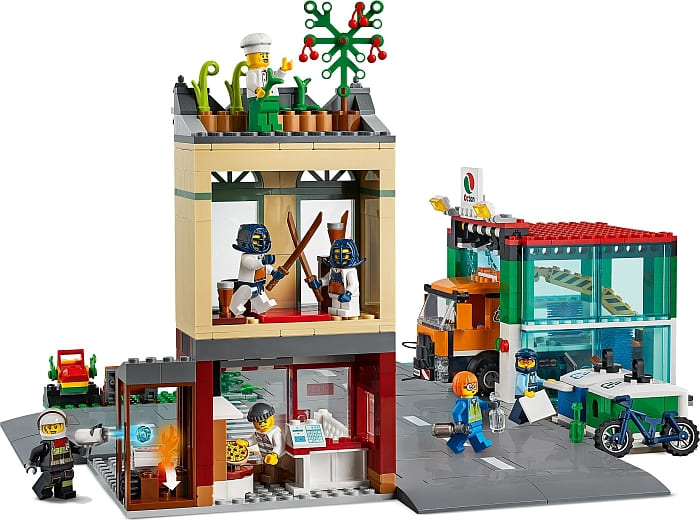
The buildings in this set are straightforward. They are also built as modules of their own. As each is finished, it gets slotted into a section along the road. Additionally, the instructions have suggestions for other arrangements of how you can lay out your growing city.
I must admit, this set is what sold me on the new road system. It has a ton of flexibility in its design. And most of all, you get a super slick polished look when everything is finished. LEGO designers wanted the road to look clean and presentable and they’ve done a great job with it.
THE #60306 LEGO CITY SHOPPING STREET
At $80 USD retail, I like the look of the #60306 LEGO City Shopping Street the best. It features a straight bit of road with a couple of stores. Minifigs can get some fresh baked goods at the bakery and get their cycling needs met at the sports shop. There is even a small park area with an outdoor exercise fixture where minifigs can get in shape by either doing some pull-ups or bar dips. And LEGO designers managed to maintain their environmental message by having a couple of solar powered street lights.
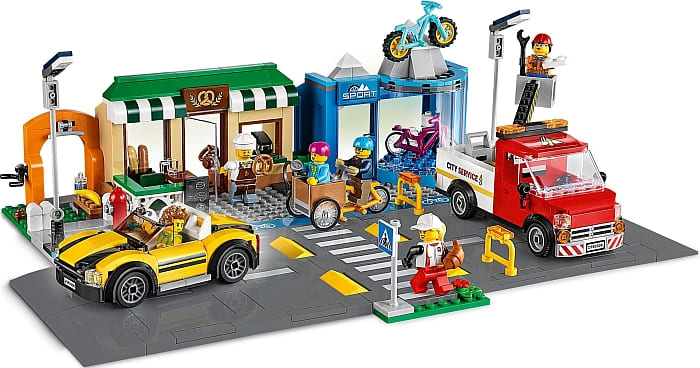
As for the road, LEGO designers show off a bit more customizing possibilities by adding in speed bumps. After all, we can’t have cars going too fast near the pedestrian crosswalk.
Like all the buildings in the LEGO City line that feature the new road plates, the buildings in this set are simple but effective. There’s just enough space and features to let you play, tell stories, and still manage to make meaningful changes to your playset to make it your own.
THE 2021 LEGO CITY ROAD SYSTEM
If you’re familiar with some of the LEGO Juniors sets (now called LEGO 4+) LEGO has released in recent years, you might have some idea how these two-plate thick modules work. Along the edges, they have four-stud sections that allow you to secure them together or simply add a 1×4 tile to create a smooth edge. In the middle of these modules are spaces that are 2×4 in size so you can either add decorated tiles like the dash line, or plain dark-bluish-gray tiles (dark-stone-gray) to continue the road.
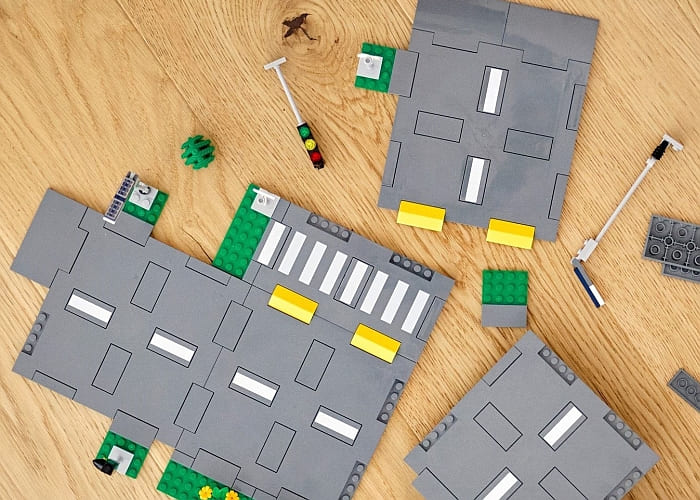
The smooth appearance of the roads is what many adult fans look for when building cities. Modular Buildings like the new #10278 LEGO Modular Police Station have become the standard for how adults want their city to look. In that regard, these new roads won’t look out of place.
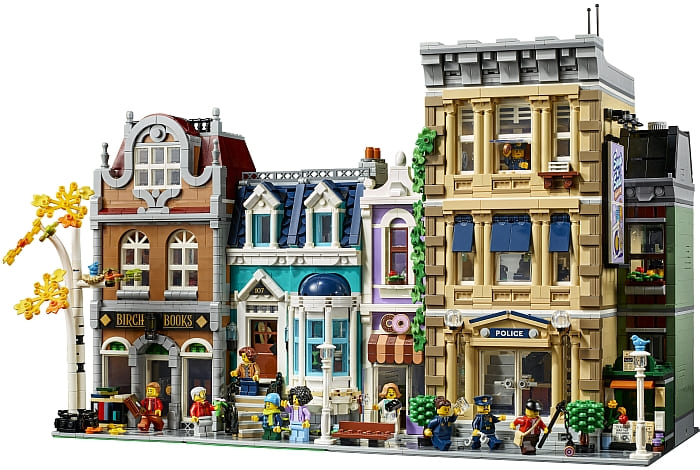
However, it should be noted that there is a height difference between the road elements and the street section of the Modular Buildings. This can be solved in a couple of ways, which we talked about in a previous article. If you wish the transition to be perfectly smooth you can rebuild the Modular Buildings on large standard plates, though I’d go even simpler. By sliding a loose baseplate under your existing Modular Buildings, the street of the Modulars will sit half a plate higher than the road. This creates a tiny curb that is ideal in a city setting.
Now let’s talk spacing. The roads are made to be 16 studs wide. This means each of the two lanes are 8 studs wide. Therefore, you can easily accommodate a vehicle that is either 4 or 6 studs wide with some room for any mirrors that might stick out from the vehicle.
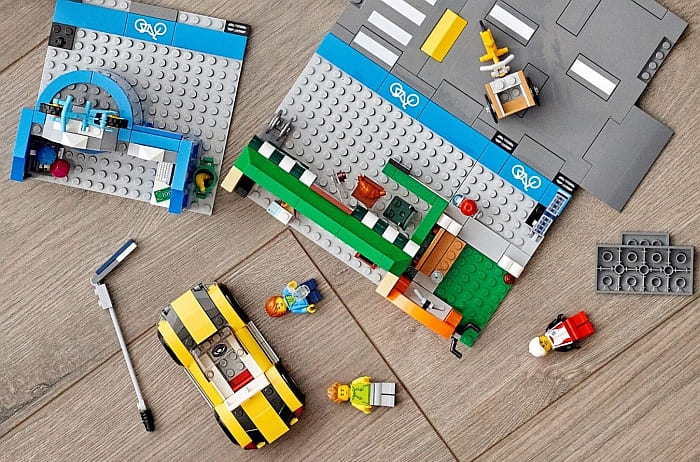
The only downside is trying to get enough of these road plates for your city. The #60304 LEGO City Road Plates set is only $20 USD retail and therefore the most affordable way to get more road plates. It does seem like LEGO is set on going forward with this system, so they will likely release more sets (and perhaps even more configuration options) in the future. In the video below, I share some additional thoughts about the new LEGO City sets and the road plate system.
Overall, I’m seriously considering how to get my hands on a large quantity of these road plates for displays with my LUG in the future. These sets have convinced me of their usefulness as they make it possible to easily integrate the Modular Buildings with some smaller vignettes. All the guess work has been taken out and everything looks sharp and nicely finished. I’m also impressed with the two larger LEGO City sets we talked about above. It really feels as though scenarios were thought out for the characters. Even the vehicles serve a vital purpose in showing off just how nice the roads are. In the future, I can easily see these as sets that adults will spend hundreds on since they remember them being so cool when they were kids. I’m going to keep an eye out for more sets like these featuring the road system. If you want to get any of the 2021 LEGO City sets with the new road plates, visit the LEGO City section of the Online LEGO Shop.
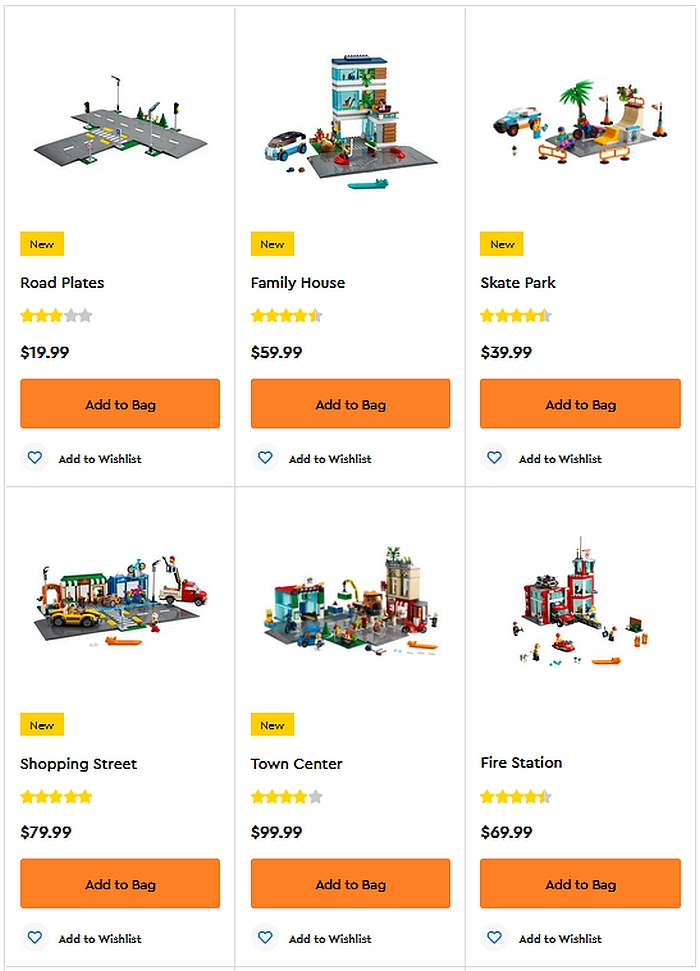
What do you think? How do you like the new road plate system introduced with the 2021 LEGO City sets? Do you have any of them already? Did you incorporate them in your own LEGO City? Feel free to share your thoughts and own reviews in the comment section below!
And you might also like to check out the following related posts:












I like the road plates more and more. The versatility is so much better than the old road plates. But I hope they will also address curves at some point.
After watching Jang’s review on the road plates, I was convinced I have to try them. And I love the bike lane!
I was able to snag a set of the new road plates at a local Target and after playing with them I worked out a double-wide lane setup in front of the Green Grocer. I also like that it provides some curb-side parking (and maybe some curb-side delivery since Covid-19 is still ongoing… )
https://www.deviantart.com/robbhunter/art/20210210-113542-870866178?ga_submit_new=10%3A1613751191
Nice! I like how you made the transition.
Have ZERO desire to retrofit my city with a mills plate strategy and have to elevate buildings. The cost in relation to value is simply not there to be worthwhile. I’d rather have sidewalks over road. Already didn’t like the speed champion line getting widened. Plus most people are already pressed for room.
Jason, if you already have an established city, there is no need to redo it. However, if someone is just starting out the new road plates are actually better as they can be used in so many different ways. Including, making narrow roads to save space.
Like Jason, I have no desire to retrofit my city with other roads.
It would seem to me that 16 x 16 (and 8 x 16) plates with tiles on top of them would accomplish just what these new road sections do, and be much more versatile. Please correct me if I’m wrong.
Real roads are at least three lanes wide with two lanes reserved for parking. A two way street would therefore have four lanes. That’s the key problem with the old plates: no parking lanes and no easy way of having a highway with 2-3 lanes going in each direction. But I (and most others) don’t have room for 2-3 lane highways or parking.
Felexibility would require both curves (which the old road plates have) and big triangle pieces (bases and plates) so one can make roads at an angle.
What we really need are large (4×4 and 6×6) dark grey tiles in big inexpensive bags, so we can make our own roads.
These big road pieces do lend themselves to bridges and overpasses, but no more so than 16×16 plates (with studs under them.)
In terms of the sets, they are all overpriced. I also don’t subscribe to LEGO pushing all the inclusion and climate change business in their toys.
Again, what am I missing?
Mark, there is no need to retrofit such a huge city as yours. However, for people, and especially kids, who are just starting out with their cities, the new road plates offer more options for customization. Both systems have plusses and minuses, so just go with the system you like. 🙂
As far as the climate change elements, LEGO has been big on that for many years now. And not just in their toys, but also in their offices and factories. They aren’t just doing it because it’s trendy right now. They truly believe in the importance of sustainability.
And in regards to the inclusion of disabled children and adults, this is something that has been received with overwhelming positivity by children, parents, and educators. LEGO is actually quite late in this. Playmobil – another well-loved European toy manufacturer and a rival to LEGO – has been representing various disabilities for decades. Disabled children need to feel that they have a place in society. They are not doomed to failure or are shunned just because they have a disability. Seeing themselves represented in toys and various forms of media helps them to expand their horizon, see the possibilities available to them, and prepare for their future. And it also helps fully abled children to better understand and able to relate to their disabled peers.
The question remains how the new road plates are different/better than 16×16 plates covered with dark grey plates. Speed bumps, hockey goalposts, etc would all connect to to 16×16 plates.
Hmm, I have way too many road plates of the earlier generations to take a bet on this system.
Otherwise, that Xtra road tape is unfortunately too narrow for most vehicles wider than bikes or scooters.
And the system still seems way too square and angular. I’m curious on how one is supposed to build things like curves, bridges, 45 degree intersections or Y junctions…
I am just starting my LEGO city and have only built the Assembly Square so far. When I read about the new road plates I got caught up in the onslaught of negative comments about them. I bought some of the old large road plates and a set of the new road plates to see for myself which was best FOR ME. Well I am sorry to say this as it isn’t the status quo but I much prefer the new system and consider myself very lucky the LEGO came out with them right when I am starting to build my city. The old system is far to wide for my “city on two shelves” and the new system suits me perfectly. I plan on building all my modulars from now forward on a double baseplate and will have a raised sidewalk with a curb where it connects with the road plates. I am glad I can use this new system and also glad I didn’t follow a bunch of people who were buying all the old plates they could find.
The question remains how the new road plates are different/better than 16×16 plates covered with dark grey plates. Speed bumps, hockey goalposts, etc would all connect to to 16×16 plates.
Mark, that’s another option. 16×16 plates are still relatively new though. And with those, you have to cover the entire plate with tiles to make it smooth. Also, it wouldn’t be possible to completely center a white line to separate the lanes. The new road plates, on the other hand, are already mostly smooth and they come with printed 2×4 tiles for the lanes.
Presumably, one will be able to buy 2×4 dark grey tiles with white lines, at least on the secondary market.
So far, it doesn’t appear that LEGO is offering packages with just the new road system (without lights, trees, etc. The question is whether it will be cheaper to buy the new road plates with related tiles or 16×16 plates with tiles.
Yes, price is definitely going to be an important consideration when comparing different methods of building roads.
Hi,
I’m not quite convinced this new system is thought out properly. The shopping street has a bike lane and a pavement, the others sets don’t and the buildings are connected to the street directly. The old plates had a pavement. I’d rather had them adding the bike lane an a pavement to the street set itself, or at least every set should look like the shopping street. Some Lego YouTubers are adding the new system into their MILS plate system, by extending the design. I just think this is too expensive.
Yes, the new system can get pretty expensive for those who have a large city. But it offers more flexibility. Some people mix the old and the new system, which can work as well. 🙂